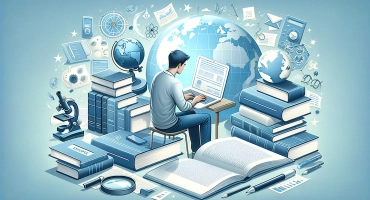Synthesizing Sources
Table of contents
- 1 What is Synthesis?
- 2 Types of Synthesis
- 3 Synthesis Matrix
- 4 How to Synthesize Sources?
- 4.1 Understanding Your Purpose
- 4.2 Carefully Select Sources
- 4.3 Organize Your Sources Using Synthesis Matrix
- 4.4 Read and Annotate Thoroughly
- 4.5 Themes and Patterns
- 4.6 Develop a Thesis Statement
- 4.7 Organize Your Synthesize in Writing Strategically
- 4.8 Highlight Important Topic Sentences
- 4.9 Integrate, Don’t Summarize
- 4.10 Use Multiple Sources per Point
- 4.11 Paraphrase Effectively
- 4.12 Reflect on the Synthesis
- 4.13 Revise, Edit, and Proofread
- 5 Example of Bad Synthesis
- 6 Example of Effective Synthesis
When composing any academic piece, be it a research article or literature review, synthesizing sources is something you will undoubtedly have to do. At a certain point in academia, simply summarizing the views and arguments of the authors of the books you read is insufficient. You must be able to draw upon what is being said across a range of sources and make wider conclusions.
Anyway, writing a synthesis essay is not always easy. This article will explain what it is, how to use a synthesis matrix to aid the process, and some good and bad examples.
What is Synthesis?
It is the process of effectively combining integration and analysis so that the flow of your writing is maintained whilst still engaging in the texts in a meaningful way. Meaning that in a properly synthesized piece of work, the reader should be able to be shown the key points from all of the sources mentioned, when and where they agree or disagree, all without breaking stride.
Analysis vs Synthesis
It would be easy to equate analysis and synthesis, but as alluded to already, there are some key differences separating the two. The analysis is the act of critically engaging in the material at hand. That means the views of the author should be explained, but then also assessed as to whether they are convincing or not. This can be done through the lenses of empirical data or by comparing them to other academic critics.
In contrast, synthesis takes the analysis of two or more sources and links them together into a coherent and well-structured paragraph by putting them in conversation with each other. Thus, it would be possible to analyze without synthesizing but impossible to synthesize without analyzing.
When it comes to research paper writing, synthesizing sources is an important task for any student. This involves collecting information from several sources, analyzing it, and then combining it to create a unique paper. Since this process can be quite challenging, many students look for ways to lighten the workload and write my nursing essay with the help of experienced professionals. Expert writers have the skills and knowledge to synthesize sources, ensuring that the resulting paper is comprehensive and meaningful. They also know how to use the sources to provide new information and give a fresh perspective to the topic, creating a paper that stands out from the rest.
- Free unlimited checks
- All common file formats
- Accurate results
- Intuitive interface

Types of Synthesis
There are two ways to synthesize information that you should be aware of, as your essay may require one or the other depending on the topic.
Explanatory
Explanatory synthesis explains the perspectives of authors and the reasoning behind them rather than dealing with the synthesis of findings. It deals largely with the context of sources and the motivations for the views concluded and compares them in this way.
Argumentative
Argumentative syntheses are concerned with the arguments presented by the sources. This means it deals with the explicit views propagated and the similarities and differences between sources.
Synthesis Matrix
Sometimes it can be difficult to figure out how to synthesize well. Still, using this simple process, synthesizing information is easier than ever. To ease the process of crafting a synthesis paragraph, the best thing you can do is break down the job into different, smaller parts. The best way to do this is by creating a summary table in which you can record smaller data points from each source. This summary table is known as a synthesis matrix.
Here is an example of what your summary table might look like at the end of the synthesis process.
|
Lako (2014) |
Loskin (2022) |
Horibe (2022) |
|
| Images | Multiple ethnicities are irrelevant in certain countries | Some countries require a specific ethnicity to be shown | Images must always be localized |
| Colours | Play no role in localization | Must be localized only on few occasions | Colors are key elements for website localization |
| Layout | U.X. is universal | Layout should change only for specific countries | Layout must change to accommodate different languages’ specs |
In this summary table, all the information from multiple sources is presented visually, so to make the synthesis of sources considerably easier when it comes to doing it in your literature review. This is a vital part of producing your report, as having evidence in the essay is essential. Drawing comparisons when everything is presented in front of you should help you organize your paragraphs and embed source synthesis more smoothly than you otherwise might have.
However, in order to make this a productive use of time you need to ensure you collect relevant data from each source, instead of wasting time finding out unnecessary niche facts that you will never use. As has been displayed in the example, a sensible way to go about categorizing the ideas of different sources is by recording their approach and then their views on a variety of issues. By collecting this, you can organize your thoughts and then engage in both explanatory and argumentative synthesis.

How to Synthesize Sources?
Whether you’re a student embarking on a research project or a seasoned academic looking to refine your writing techniques, we share with you valuable insights into the process of synthesizing sources for maximum impact on your work
Understanding Your Purpose
Understanding your purpose is the compass that navigates the intricate process of synthesizing sources. Before embarking on the synthesis journey, clarify the fundamental question: why? Whether the aim is to present a fresh perspective, compare and contrast theories, or contribute to existing synthesizing research, a clear sense of purpose sharpens the focus.
Carefully Select Sources
The foundation of a robust synthesis lies in the careful selection of sources. Opting for reputable authors or publications fortifies the work’s integrity and ensures the synthesis is built upon a solid foundation of trustworthiness and expertise.
Organize Your Sources Using Synthesis Matrix
Gather the sources you have reviewed and begin to break down their parts. It is recommended to find out the context of all the sources, including the time they were written and the author’s approach used. Summarizing the authors’ views on the critical issues in the discussion is a great idea to make drawing comparisons seamless.
Read and Annotate Thoroughly
Scribble in the margins, underline pivotal or specific concepts and jot down insights. Through this meticulous reading and annotation, the writer not only absorbs the substance of each source but also lays the groundwork for a synthesis that harmonizes diverse voices into a cohesive and insightful narrative.
Themes and Patterns
Identify themes, research questions, patterns, and recurring arguments that echo across the literature. Like a skilled detective, discern the commonalities that unite disparate voices. Grouping similar ideas helps unlock a comprehensive understanding of your topic. By identifying recurring themes and trends, you illuminate the underlying connections and lay the groundwork for constructing a nuanced and layered synthesis.
Develop a Thesis Statement
Your thesis should transcend mere restatement and serve as a fresh and compelling lens through which the synthesized sources are refracted. It is the moment to distill the essence of synthesizing articles into a concise and potent statement.
Organize Your Synthesize in Writing Strategically
The thematic organization may be chosen if common threads or overarching themes tie your sources together. Opt for a comparative approach when highlighting contrasts and similarities among sources. Alternatively, a chronological order may be suitable when tracing the evolution of ideas over time.
Strategic organization aligns the elements of your synthesis in a logical progression, guiding readers through a thoughtfully curated journey.
Highlight Important Topic Sentences
Topic sentences are essential for effectively integrating what you have found. Without them, your paragraph will sound clunky and challenging to read. Thus, think about the specific theme and topic you are communicating about and develop a good framing sentence that sets the scene for further development in the form of the authors you will use.
Integrate, Don’t Summarize
Integrating sources involves a thoughtful dialogue where the conversation transcends individual voices. Discuss the intersections where ideas converge, highlight the divergences that spark intellectual curiosity, and elucidate the unique contributions of each source to the collective narrative.
Use Multiple Sources per Point
By weaving together insights from various authorities, you comprehensively understand the topic and invite readers into a multidimensional exploration. This meticulous approach adds weight to your claims.
Paraphrase Effectively
Paraphrasing bridges the voices of your sources and your authorial voice, seamlessly integrating the main idea and external ones into the fabric of your narrative. By expressing concepts in a personalized manner, you demonstrate comprehension and enhance the flow of your synthesis. This deliberate engagement with the material respects the sources’ intellectual property and allows you to present a cohesive and nuanced synthesis that is distinctly yours.
Reflect on the Synthesis
Take a moment to assess how effectively the synthesized sources bolster your thesis. Reflecting on biases is paramount in ensuring the integrity of your synthesis.
Revise, Edit, and Proofread
As with all synthesis writing, the more time you spend doing it and reviewing the synthesis of information you have done, the better it will be. Thus, take your time synthesizing the literature to make it as good as possible. Then, revisit it with fresh eyes to see if you still like your work. For instance, when writing a synthesis essay, there are many ways to produce a successful piece.
To make sure your work is unique, use programs that help to avoid plagiarism.
Example of Bad Synthesis
The text below is a bad example of synthesis. Notice that it is a struggle to read and doesn’t flow well at all.
The National Heart, Lung, and Blood Institute argues that parents should “start tracking how much time your family spends in front of a screen.” This way, we can monitor and control our dependency on technology. Screen usage is only rising, and the effects it could have on young people and their ability to socialize could be drastic. Katherine Lee of the Verywell family also says that excessive use of technology is a problem as it becomes an “emotional crutch to escape sadness or boredom.”
Example of Effective Synthesis
This example is much more successful. Try to spot the techniques that allow one synthesis example to read better than the other.
Like it or not, technology is an essential tool to how we live our lives in the 21st century. However, following this tech revolution, The National Heart, Lung, and Blood Institute has argued that parents should “start tracking how much time your family spends in front of a screen.” This is a practical way we can start to make good choices and avoid dependency.
This is a popular suggestion among other thinkers, with Katherine Lee of the Verywell family also advocating that excessive use of technology can enable children to use their phones as an “emotional crutch to escape sadness or boredom.” This is a serious problem that could have drastic effects on young people and their ability to socialize and empathize with each other.







